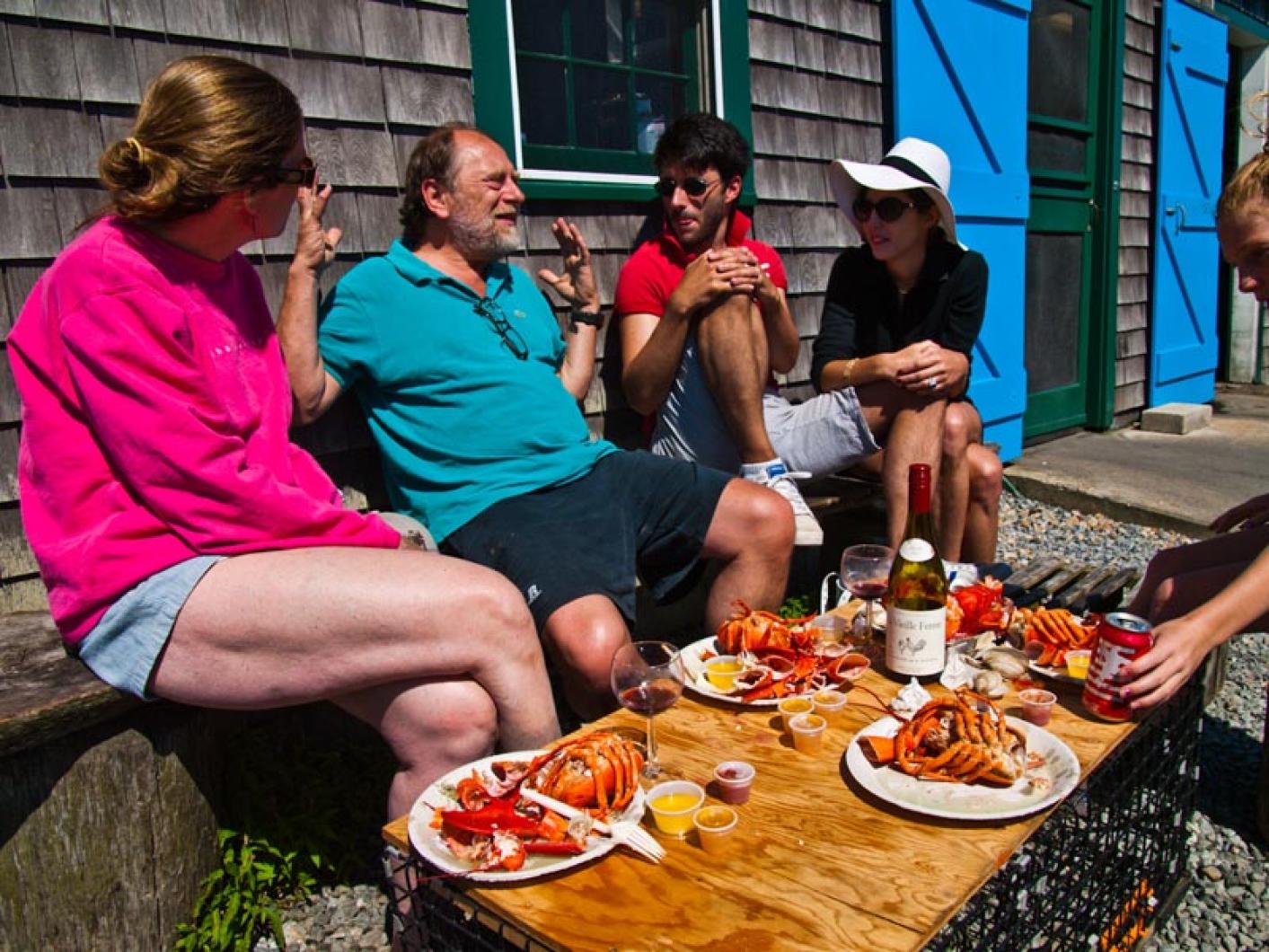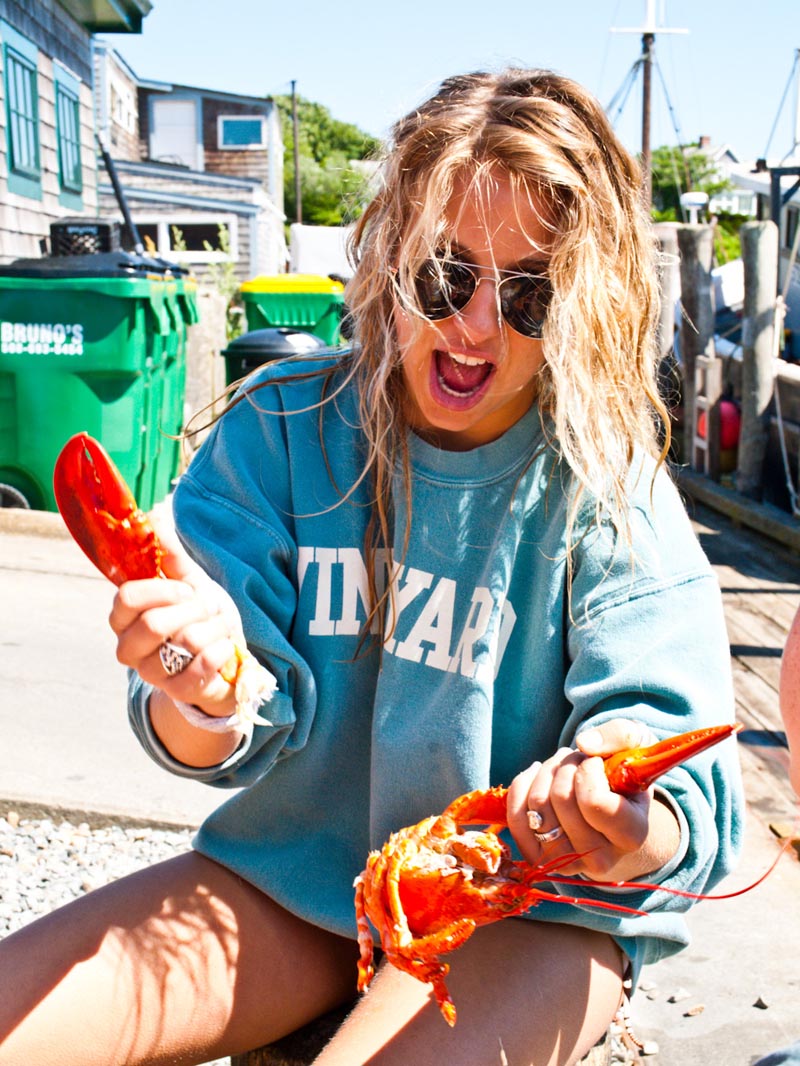Being in love is like eating lobster on the beach as the sun sets over the ocean on a cool evening in July. It is the feeling of washing down each butter-bathed morsel with a cold swig of bubbly wine, then stripping down and cleansing the remnants of the day away by diving head-first into the cool water. Being in love is knowing, while you swim, how lucky you are to warm yourself with the heat of someone else’s body, wrapped up together in one towel in front of a gentle fire as the night grows darker and the air cooler.
Burying your feet in the sand off the edge of the blanket gives memories of the day, different layers of warmth starting at the surface and cooling as you stick your toes farther and farther under. The fire was started as the day was winding down and the sand still accepted the heat of the sun. One of those big old pots, meant only for steaming lobsters, bought by your parents when they were falling in love, is used to scoop up just enough water to cover the seaweed you gathered on the tideline. The lobsters meanwhile unsuccessfully try to climb their way out of the five-gallon bucket housing them.
Eating on the beach means no chance of having a lobster make a break for it across the kitchen floor, which has happened to me once or twice and was immortalized by Woody Allen in the classic movie Annie Hall. In their beach home in the Hamptons, Mr. Allen and his lover Annie, played by Diane Keaton, watch their meal escape across the kitchen floor and behind the refrigerator.
“Look, I told you it was a mistake to ever bring a live thing in the house . . . We shoulda gotten steaks ’cause they don’t have legs. They don’t run around.”
Woody Allen can be overly dramatic, and catching a lobster on the loose is an easy task, but I see it as an argument for cooking and eating lobster outside. Eating a steamed lobster is a messy task and eating under the stars or outside at a picnic table or on a dock somewhere means no mess to clean up afterward. Stripping away those formalities while focusing only on what is important simplifies the experience. And what is important is a properly steamed lobster, a copious amount of butter, paper towels and some tools for getting at the meat if you are too shy to use your teeth to crack the shells.
Cooking lobster is straightforward. But like most all seafood, due to its tightly-bound muscle structure and lack of the lubricating fat that makes cooking meat a more forgiving process, lobster cookery can go wrong easily. You want to cook lobster just through. Cooking it too much makes for a rubbery, dry and unfortunate situation, and too little will result in an odd texture and undeveloped flavors. If you start by steaming a lobster whole, the simplest way, you have endless options once the meat is picked clean for any number of recipes. My calculations for a perfect steamed lobster are simple: for each pound of lobster you need to cook, add five minutes steaming time always followed by five minutes to rest and cool. So a one-pound lobster will steam for five minutes, a pound and a half will steam for seven and a half minutes and a two-pounder will take 10 minutes. Each will rest for 5 minutes and then be shelled.
The two simplest preparations of lobster are the ones that I am constantly drawn back to. That is the steamed lobster, and I always try to cook one or two extra as to have enough to make lobster rolls the next day with the leftovers, the second-best option. The best lobster roll I have ever eaten was at Pearl Oyster Bar on Cornelia street in the West Village of Manhattan. The buttery toasted hot dog bun, the crunch of the celery and the chunks of lobster dressed simply in mayonnaise and lemon made me weak in the knees with joy. I sat at that bar five years ago on my birthday, alone, eating a lobster roll. I hadn’t gotten out of bed all day due to the flu and had mustered the strength to make my way there through the beginning of a snowstorm. As I came upon the tiny awning in front of the restaurant, I could make out someone on a ladder changing a light bulb while another held the base for them. They were both in chef coats and as I got closer I recognized the one on the top of the ladder as the chef and owner.
In a time when chefs have become too big for their britches, and many own restaurants they have not stepped in for years, here was a woman braving the elements to change a light bulb herself on an icy ladder during a snowstorm in January. Rebecca Charles is a purist, and the quality of her ingredients speak for themselves. She makes the best lobster roll I know of, and when asked, in an interview in 2006 by Frank Bruni of the New York Times where she travels for vacation and inspiration, she answered that when she isn’t working in the kitchen 70 hours a week she will drive up to the Maine coast and eat lobster. That is my kind of chef.
As you pop your head out of the ocean, the sun setting in front of you, your fire crackling on shore behind you with an extra lobster or two sitting in the pot beside it, be sure the lid is on that pot. Or else you may helplessly witness a seagull swoop down to steal what was meant to be tomorrow’s lunch.








Comments
Comment policy »